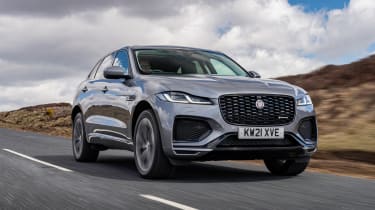Jaguar F-Pace (2016 - 2024) – engine, gearbox and technical highlights
Four-cylinder options aren’t great, but the six-pot engines makes up for this. The PHEV solid, too
There’s been some pretty big movers and shakers in the powertrain line-up as previously mentioned, but the technical aspects of what’s really going on under the F-Pace’s bonnet is more impressive than the figures might suggest.
Starting with the diesel, the motor have been synced up with Jaguar’s mild-hybrid system that utilises a belt-integrated starter generator (BiSG) which harvests energy under braking to later assist under acceleration and to optimise the start-stop system. The four-cylinder D200 model comes with 201bhp, but the real star of the show is the 296bhp D300 straight-six which was introduced in late 2020. It’s part of the series of Ingenium 6 engines that are found across the JLR range, and serves the F-Pace just as well here as it do in its larger and heavier Land Rover cousins.
There’s a single 247bhp P250 2-litre turbocharged petrol engine which is, SVR aside, the only non-electrified model in the range. It’s a thirsty and relatively gutless engine that’s not really designed for Europe, feeling instead like an entry-level powertrain option for overseas markets. The P400 straight-six petrol has perhaps the most interesting mild-hybrid set-up of the range, though, as its system doesn’t just employ a BiSG, but also features an electrically powered supercharger that works in conjunction with the twin-scroll turbocharger. Its job is also to torque-fill before the traditional gas-driven turbocharger wakes up, but does this to much greater effect than just the BiSG on its own.
More reviews
In-depth reviews
Long term tests
Reviews
- Jaguar F-Pace SVR (2019 -2024) review – a brutal and charismatic fast SUV
- Jaguar F-Pace SVR Edition 1988 2023 review – V8 range-topper takes inspiration from Le Mans
- Jaguar F Pace P400 HSE 2021 review – popular SUV refreshed, but can it take on a Macan?
- Jaguar F Pace (2018-2020) SVR review - SVO upgrades combine to create Macan Turbo rival
Yet despite its 394bhp and 406lb ft of torque, it still isn’t generally suited to the F-Pace on account of its thirst. The engine itself, however, is a brilliant unit, but we just can’t help but be disappointed that it won’t be found in anything more dynamically focused. Finally, there’s the P400e plug-in powertrain, which pairs the turbocharged four-cylinder petrol engine with a 105kW (141bhp) electric motor and 17.1kWh battery pack. Total system figures are 398bhp and 472lb ft of torque, but ultimately vary depending on system load and revs. Jaguar claims a combined all-electric range of 32 miles.
The PHEV’s layout is relatively simple, with the electric motor sandwiched between the engine and transmission, an inverter placed on one side of the gearbox, and the battery pack sitting underneath the boot floor. As with all F-Pace models, all the system power is routed through the one transmission and all-wheel-drive system, which retains its rear-biased and adaptive torque split.
The transmission used on all models is the same eight-speed automatic from ZF. The transmission is crisp, responsive and very clean between shifts. However, four-cylinder models retain a sense of inertia throughout the powertrain that makes it feel a little clunky. Six-cylinder models are more responsive, and feature transmission mapping that will give a little flourish of revs on downchanges and bursts of torque going up the gearbox.
The SVR’s supercharged V8 is unchanged, so while it may lack the full-house 567bhp of an F-Type R there’s still plenty of performance with 542bhp on tap. The only updates that have been applied to the SVR’s powertrain are confined to the gearbox, which has picked up new mapping software from the Project 8. Best not underestimate what otherwise seems like a subtle change, though, as it’s transformed the car, giving it some real attitude and panache that matches its superb chassis tuning. It might not be the newest or fastest high-performance SUV around, but the F-Pace is very, very close to the top of the pile.





